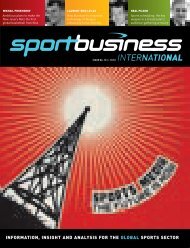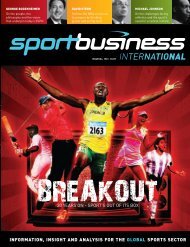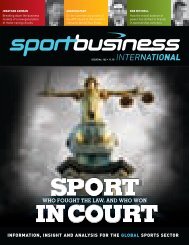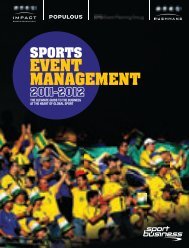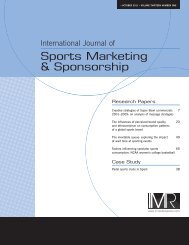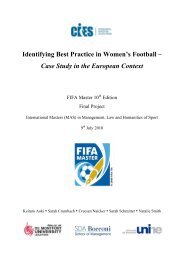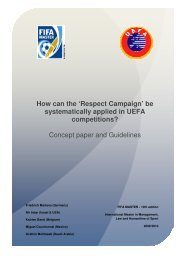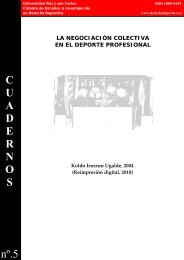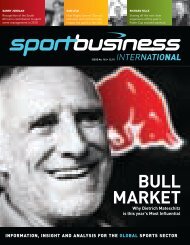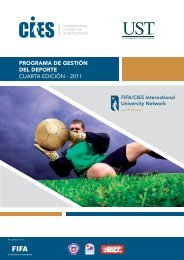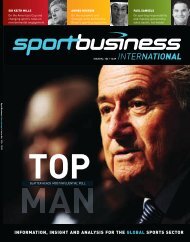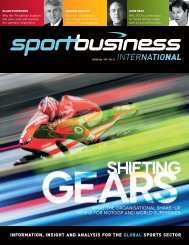Sports Marketing & Sponsorship - FIFA/CIES International University ...
Sports Marketing & Sponsorship - FIFA/CIES International University ...
Sports Marketing & Sponsorship - FIFA/CIES International University ...
- No tags were found...
Create successful ePaper yourself
Turn your PDF publications into a flip-book with our unique Google optimized e-Paper software.
Can sponsorships be harmful for events?respondents were randomly assigned to one of twoexperimental groups. We measured the respondents’associations with the event and with the sponsor bymeans of the attributes ‘tough’, ‘boring’, ‘sporty’,‘young’, ‘cosy’, ‘alternative’, ‘formal’, ‘old fashioned’,‘reliable’ and ‘slow’, because the pre-test revealedthese were the relevant associations worth exploring.ResultsThe statistical analysis utilised multiple analysis ofcovariance (MANCOVA). There are two reasons for thischoice of method. First, MANCOVA’s capability fortesting the influence of factors on several metricdependent variables supports a simultaneousassessment of the change in all associations with theevent. The experiment-wide error rate is thereby takeninto account. Second, MANCOVA allowed us to controlfor several continuous variables. These included theindividual’s involvement with each brand and theperceived fit between the brand and the event.The MANCOVA showed that the sponsoring brandhas a significant effect on associations with the event,F(10,99)=2.357, p=0.015. Tests of between-subjecteffects indicated that not all associations with the eventare affected. The outcomes are per attribute (inparenthesis, the level of significance, if significant):tough (0.002), boring (0.053), sporty (0.040), young(0.012), cosy (n.s.), alternative (0.067), formal (n.s.),old fashioned (0.011), reliable (n.s.) and slow (0.063).ConclusionFrom the empirical study, our central hypothesis couldbe confirmed: The image of a sponsor has an impacton the image of the sponsee. Thus we establishedthrough association transfer that not only can thesponsor’s brands be enhanced or damaged (c.f.Wilson et al, 2004; Wilson et al, 2005; McCracken,1988) by association, but that the same mechanismworks the other way around: The image of a sponseecan be influenced by a sponsorship from a particularsponsor. This finding has important implications bothfor marketing practice and theory.Our findings are relevant to sponsees and sponsors.Sponsees must take great care in the recruitment andselection of sponsors. (We acknowledge that this is aluxury most sponsees cannot afford.) It is importantfor event organisers to understand and use thisknowledge of association transfer as an image-buildingtool in the same way as sponsors do now. Sponseesmust also be aware of possible damage to their eventimage that might be caused by sponsors with bad ordull images. Sponsees need to attract sponsors thatsupplement their event image strengths and helpovercome their event weaknesses. The value of asponsorship for the sponsee then goes clearly beyondthe sponsorship royalty. For all parties, sponsorshipscan be regarded as a fountain of meaning. Sponseescreate meaning through their activities, and sponsorscontribute to the strong, favourable and uniqueassociations being built into an event.Our research has clearly demonstrated that thefountain of meaning is not perpetual but can beharmed by heavy consumption. The latter is the casewhen a brand with strong but unfavourableassociations sponsors an event. Due to thedeterioration of the event’s image, the value that thesponsor gets out of the sponsorship diminishes. Thiscan lead to a vicious cycle leading, at worst, to eventimage degradation and dissolution. Furthermore,sponsorship managers should consider the associationtransfers from all sponsors to sponsee when decidingupon their own sponsorships. Not only will thesponsee’s image be influenced by the sponsor’simage, but also by the images of possible co-sponsors.Our contribution resolves doubts about the existenceof sponsor to sponsee transfer effects (see, forexample, Gwinner, 1997). Although the artificialcharacter of the experiment limits the external validityof the findings, the generalisability is high due to thesound theoretical grounding. Replication wouldobviously increase the external validity. It would alsobe most valuable to consider other potentialRESEARCH PAPER● APRIL 2009 ● <strong>International</strong> Journal of <strong>Sports</strong> <strong>Marketing</strong> & <strong>Sponsorship</strong>249



